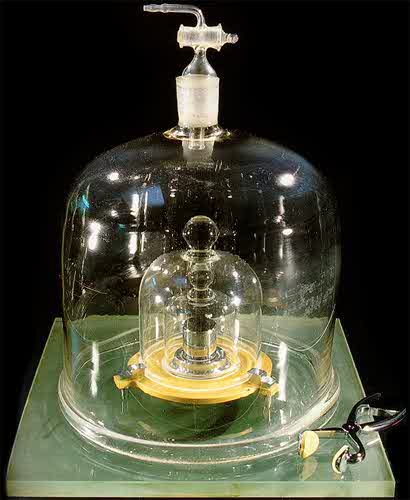The elusive kilogram!
Last night I had this conversation with Moomin. “I just want to make sure you actually understand this metric system stuff rather than doing the problems blindly. So let’s draw a little chart. How many grams in a kilogram?” “Um… ummm… ummmmmm…. Oh yeah! 1000!” “Okay, how many centigrams in a kilogram?” “There’s no such thing as a centigram.” “There is!” “No there’s not! They didn’t tell us that! Look, I wrote it down… Can you just let me finish this page? It’s my bedtime!” Bedtime is not a good time to explain the entire concept of the metric system so I gave in.
Later a certain person assured me that Moomin was right! Well, they are wrong! 8-P
And then led me into a delightfully pointless reading: Wikipedia: Kilogram.
The kilogram is the only unit not defined off a physical constant – it’s defined from this particular object, the 130-year-old International Prototype Kilogram or IPK. And a whole bunch of other metric units are defined using mass, like newtons, pascals, joules, amperes, couloumbs, volts, teslas, webers, candelas, lumens, and lux. (The plural is not “luxes”. I looked it up.) It was created and then defined as the standard. But some replicas of it were created, like the Kilogram of the Archives, and over time they have diverged from each other. The story of what they’re all made of, and how they’re periodically compared and verified, is pretty cool. And sort of insane. Is that a whole bunch of people’s life work? Making sure that we know how wrong our kilograms might be? Eeeeeee! That’s so hot!!!!!!
And so are multiple bell jars over a brass-looking pedestal thingie! It’s like The International Geek Thingamajig on a Steampunk Cake Stand of Awesome!

Burrow deeply into the kilogram article and you will get to the proposed alternatives that would tie the kilogram to a constant. Atom-counting approaches (I liked the Avogadro project, which would use a silicon sphere); Ion accumulation; and the rather sexy sounding watt balance method: the electronic kilogram!

I am tempted to show all this to Moomin but not until he finishes today’s tedious homework, which is three pages of textbook problems of temperature conversion. No one needs that many examples – it is very pointless. At the least I will wow him with the revelation that there are exagrams, zettagrams, yoctograms, and zeptagrams which I will prove through the irrefutability of Wikipedia because we all know the important thing to teach 4th graders is that Wikipedia is totally true.
